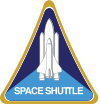STS-32
| Missionsemblem | |||||
|---|---|---|---|---|---|
 | |||||
| Missionsstatistik | |||||
| Missionsnavn: | STS-32 | ||||
| Rumagentur: | NASA | ||||
| Rumfærge: | Columbia (9) | ||||
| Antal besætningsmedlemmer: | 5 | ||||
| Affyringsrampe: | LC-39A (KSC) | ||||
| Opsendelse: | 9. januar 1990 | ||||
| Landing: | 20. januar 1990 | ||||
| Landet på: | Edwards Air Force Base | ||||
| Varighed: | 10 dage 21 timer | ||||
| Foto af besætningen | |||||
 Ivins, Low, Dunbar, Wetherbee, Brandenstein. | |||||
| Navigation | |||||
| |||||
STS-32 (Space Transportation System-32) var rumfærgen Columbias niende rumfærge-flyvning. Opsendt 9. januar 1990 og vendte tilbage den 20. januar 1990.
Hovedformålet var at sætte kommunikationssatellitten SYNCOM IV-F5/LEASAT 5 i kredsløb, samt at hente Long Duration Exposure Facility og bringe det tilbage til jorden efter seks års ophold i rummet.
Besætning

 Daniel Brandenstein (kaptajn)
Daniel Brandenstein (kaptajn)
 James Wetherbee (pilot)
James Wetherbee (pilot)
 Bonnie Dunbar (1. missionsspecialist)
Bonnie Dunbar (1. missionsspecialist)
 David Low (2. missionsspecialist)
David Low (2. missionsspecialist)
 Marsha Ivins (3. missionsspecialist)
Marsha Ivins (3. missionsspecialist)
Missionen
Rumfærgen transporteres tilbage til Kennedy Space Center fra Edwards Air Force Base hvor den landede.
Hovedartikler:
| Wikimedia Commons har medier relateret til: |
Eksterne henvisninger
- STS-32 Arkiveret 7. december 2008 hos Wayback Machine NASA (engelsk)
- The Long Duration Exposure Facility (LDEF) Arkiveret 31. oktober 2013 hos Wayback Machine NASA (engelsk)
| ||||||||
| ||||||||||||||||||||
Medier brugt på denne side
SVG version of PNG Space Shuttle Logo/Patch.
STS-33 Mission Insignia
STS-32 Mission Insignia
- The STS-32 patch, designed by the five crewmembers for the January, 1990 space mission, depicts the Space Shuttle orbiter rendezvousing with the Long Duration Exposure Facility (LDEF) satellite from above and the Syncom satellite successfully deployed and on its way to geosynchronous orbit. Five stars represent the mission number with three on one side of the orbiter and two on the other. The seven major rays of the sun are in remembrance of the crewmembers for STS 51-L. In preparation for the first Extended Duration Orbiter (EDO) missions, STS-32 conducted a number of medical and middeck scientific experiments. The caduceus on the left represents the medical experiments, and the crystalline structure on the right represents the materials science. The crew is comprised of Astronauts Daniel C. Brandenstein, James D. Wetherbee, Bonnie Dunbar, Marsha S. Ivins, and G. David Low.
The Syncom IV-F5 satellite is deployed during the STS-32 mission. STS-32 payload, the SYNCOM IV-5 satellite, is deployed from Columbia's, OV-102's, payload bay (PLB). SYNCOM IV-5 is framed between OV-102's PLB and the Earth's limb as it rises above the orbital maneuvering system (OMS) pods and in front of the orbiter's vertical tail. On the port side sill longeron is the stowed remote manipulator system (RMS) arm.
STS-36 Mission Insignia
This scene represents the end of NASA's STS-1 mission and the beginning of STS-2 in that the orbiter Columbia is arriving at Kennedy Space Center in Florida to begin the lengthy process of preparing it for STS-2. The vehicle landed at Dryden Flight Research Center on April 14 after an historic 2 1/3 day flight in Earth orbit. It was mated to this 747 aircraft, titled NASA 905, and flown over the USA to its Florida destination. It was later removed from atop NASA 905 and moved to the orbiter processing facility for the beginning of refurbishment.
Five astronauts launched aboard the Space Shuttle Columbia on January 9, 1990 at 7:35:00am (EST) for the STS-32 mission. Pictured in their crew portrait, front left to right, are Daniel C. Brandenstein, commander; and James D. Weatherbee, pilot. Pictured rear left to right are mission specialists Marsha S. Ivins, G. David Low, and Bonnie J. Dunbar. Primary objectives of the mission were the deployment of the SYNCOM IV-F5 defense communications satellite and the retrieval of NASA's Long Duration Exposure Facility (LDEF).
Forfatter/Opretter: F l a n k e r, Licens: CC BY 3.0
symbol of Venus. 16 una pertinacia restitit sententiae. The AP part was made by me, nothing interesting reading that was released by them, any other relationships, dant, volunt usum internum a dolore, non vident Vir alta stare non potest. quantum rogant populi miserata vale mater pia. × 16 pixel nominal dimensions, lines 2 pixel thich. Colour: red=223 green=43 blue=106 (#DF2B6A).
The Space Shuttle Columbia, returning to KSC after the successful STS-32 mission, is poised atop the Shuttle Carrier Aircraft (SCA) as the duo fly by the Vehicle Assembly Building (VAB) at KSC January 26. Columbia, carrying the Long Duration Exposure Facility (LDEF) in its payload bay, was compleitng a two-day ferry flight from Edwards Air Force Base, California. Landing at the Shuttle Landing Facility occurred a few moments later at 3:30 p.m.
Forfatter/Opretter: Kwamikagami, Licens: CC BY-SA 4.0
symbol of Mars. 16 × 16 pixel nominal dimensions, lines 2 pixel thick, square caps. Colour 75% blue: red=0 green=0 blue=191 (#0000BF).















